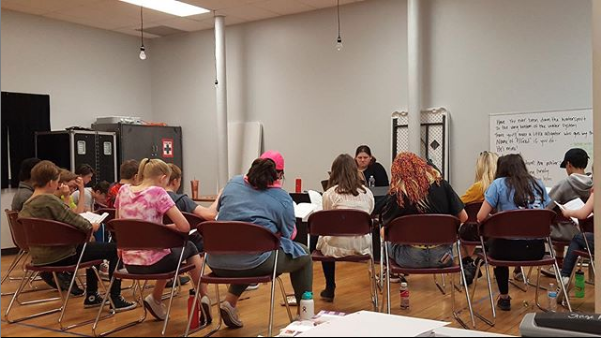FAMILY FRIDAYS: Restorative Circle Process for Racial Justice
By Kelley Nelson, Community Partnership Manager

How the restorative circle process can help your family process issues of social justice.
Your Entire Family | All Ages
A restorative circle allows for shared power as everyone is equally responsible for sharing and reflecting on their impressions and experiences with complicated issues. The process takes its cues from and is rooted in, several indigenous traditions and cultural practices (Marsh). Circles are now part of work done by legal mediators, schools, and corporations. The practice offers a chance for people to stop, to sit down, and to listen to each other. Restorative circle practices help young develop “prosocial skills and attitudes” as well as develop “a sense of community and civic spirit, empathy, and…a sense of belonging and connectedness” (Marsh). A circle practice can be used to process difficult issues with youth in your family, their peers, and their families or a youth group.

Now more than ever, we MUST have honest and potentially uncomfortable conversations about race, privilege, and implicit bias. Black folks’ lives depend on it. We need to have these conversations urgently within all of our circles- perhaps most urgently with the young people in our lives.
SteppingStone Theatre for Youth led the process with a group of 20 teens ages 12-19 and the adult artists who support them to process their feelings since the murder of George Floyd in our community. A staff member with 5 years’ experience facilitating circle processes led the socially-distanced circle conversation. The entire process was 2 hrs in length and took place outdoors with participants seated 6-feet apart with a centerpiece composed of Black Lives Matter and All are Welcome Here signs.
Below you will find a simplified version that can be used for small, intimate groups of close friends and family seeking to discuss one specific topic in one specific manner. Restorative circle process, which is rooted in several indigenous traditions and cultural practices, is now part of work done by legal mediators, schools, and corporations. We honor the training and expertise that it takes to facilitate these talks – our circle process was led by a trained professional with 5 years of experience. She is also the person who has developed this process for you.
Two or more people of similar or different races or cultural backgrounds. Recommended for all ages as the process can work well across a range of ages in a family or friend group. The topics and questions recommended below are appropriate for a tween and teen audience.
One person will lead the circle process. Invite your group to gather a specific time and place. Let them know what to bring with them in advance.
– Where is the Love? , The Black-Eyed Peas
–Changes, Tupac Shakur
-Wake Up Everybody, Harold Melvin and The Blue Notes (updated version by John Legend and The Roots)
-This is America, Childish Gambino
– What’s Going On, Marvin Gaye

Position seating in a circle.
Place your Centerpiece item in the middle of the circle.
Welcome group members as they take their seats.
Set an intention for the conversation. Your intention can be as simple as “to come together as a family” or specific as “begin a family discussion about race and privilege”.
Mindful Listening: Read aloud or listen to the music or poetry you chose as an opening. Afterward, ask participants to choose a lyric that spoke to them and share why.
Share Objects: Ask participants to share their meaningful objects with them to circle. Ask them to descirbe the object and why it is meaningful to them. When they finish their turn, place each object in the center of the circle.
Values: Participants share one value they bring into the circle today. Examples of values might be: open-mindedness, courage, vulnerability, compassion, or active listening.
Rounds: Use the Talking Piece to pass and to indicate who is speaking. Each participant shares their thoughts on questions like:
-What role has race played in your life?
-What role can our group/family play in supporting each other in learning about race and social justice?
-How are you experiencing the events happening in our city?
-What action steps can our group/family commit to support racial justice in our community?
Closing: Each participant shares one word about the circle process experience.
Dig into these resources to deepen your understanding of Restorative Circles:
“About the Circle Process”, by Living Justice Press
“Restorative Practices Require Power Be Redistributed to Black and Brown Children”, by Barbara Sherrod via Juvenile Justice Information Exchange.
“Talking Circles” by First Nations Pedagogy Online.
“The Power of Circle” by Sarah Super via YWCA Minneapolis.
Learn more about how Saint Paul Public School District are using Restorative Practices with students:
Restorative Practices in Saint Paul Public Schools.
This summer, SteppingStone Theatre has a place for young people to come together, process big issues in their world and discuss impactful social change.
Social Change: Act Now (Grades 4-6th)
Theatre for Social Change (Grades 7-12th)
Boyes-Watson, Carolyn, and Kay Pranis. Circle Forward: Building a Restorative School Community. Living Justice Press, 2015.
Marsh, Courtney. “Honoring the Global Indigenous Roots of Restorative Justice: Potential Restorative Approaches for Child Welfare”. Center for the Study of Social Policy. 1 November 2019. https://cssp.org/2019/11/honoring-the-global-indigenous-roots-of-restorative-justice/.
McCammon, Becky. Restorative Practices at School: an Educator’s Guided Workbook to Nurture Professional… Wellness, Support Student Growth, and Build Engaged Classroom Communities. Ulysses Press, 2020.
Kelley Nelson is SteppingStone Theatre’s Community Partnership Manager. Trained by Hanaa Arafat and Alexis Goffe through the Community Mediation and Restorative Services organization, Kelley Nelson has been a circle keeper for 5 years. It is another tool she has been able to use in her 20-year career in cultural competency and youth development.
Tags: Family Fridays, Social Justice